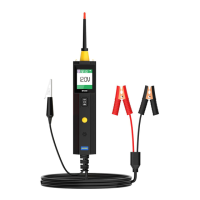If the green LED went off at that instant or if the circuit breaker
tripped, the tool has been overloaded. This could happen for the
following reasons:
If the circuit breaker is tripped, reset it by waiting for it to cool
down (15 sec.) and then depressing the reset button.
The contact you are probing is a direct ground or negative
voltage.
The component you are testing is short-circuited.
The component is a very high current component (i.e., starter
motor).
Connect the ground auxiliary wire to the ground of the trailer
lights when in DC voltage mode, and insert the probe into the
OBD pin to display the real-time voltage. By using this method it
is possible for you to check the function and direction of the
12
Once you extract a DTC from the vehicle and realize that trouble-
shooting begins with some kind of sensor circuit, there is a quick
test you can perform to verify the code.
Testing your sensor is easy while using the tool. For example, you
suspect there is a problem with your M.A.P. Sensor circuit, then
follow the procedure involved with testing this sensor:
While the tool is in DC Voltage mode, by using the probe tip in
connection with the auxiliary ground lead, components can be
activated right in your hand, thereby testing their functions.
Connect the auxiliary ground lead to the negative terminal or
ground side of the component being tested. Then contact the
probe tip to the positive terminal of the component, the green
LED should light, indicating continuity through the component.
While keeping an eye on the green LED, quickly press and
release the power switch forward. If the green LED went out and
the red LED came on, you may proceed with further activation.
Rock the power switch forward and hold it down to provide power
Test trailer and
connection
status
●
●
●
to your component. With the power switch rocked forward, power
will flow from the positive lead on the battery into the probe tip,
through the tip into the component’s positive terminal, into the
component and out of the component, through the auxiliary
ground lead and back into the tool, and back to the vehicle
battery’s ground.

